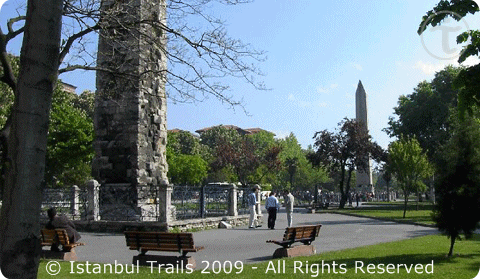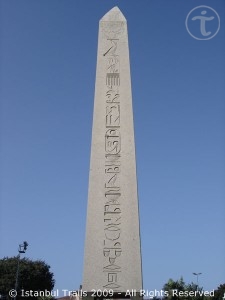The Hippodrome (At Meydanı) was a of course a horse-racing track, what’s in the name. But during the Byzantine Empire, the hippodrome was not only used for chariot races. Court ceremonies, coronations and parades also took place at the hippodrome, making it the sporting and social center of Byzantine life for over 1000 years. The reason why some refer to it as the Hippodrome of Constantinople.

History of the hippodrome
The idea for the hippodrome originally came from Emperor Septimius Severus in 203. He came to Byzantium to beat down a rebellion in a Roman civil war, after which he raised the city walls, slaughtered most of the inhabitants, and introduced an arena for chariot races and other entertainment.
But it wasn’t until the arrival of Emperor Constantine the Great in 324 that the hippodrome got its final shape. Besides moving the seat of the government from Rome to Byzantium, renaming the city over Nova Roma (New Rome) to Constantinople, one of his greatest accomplishments was the renovation and enlargement of the existing hippodrome.
The new u-shaped track was about 450 meters long and 130 meters wide, surrounded by a stadium with a capacity of approximately 100.000. Constantine also connected the emperor’s box (kathisma) to the then nearby Byzantine Great Palace via a passage which could only be used by the emperor and his family.
Political races in a magnificent hippodrome
At the northern end of the racetrack, where now the tourist information office is located, stood the Hippodrome Boxes, containing four statues of horses in gilded copper. The southern end was occupied by the Sphendone, the hippodrome’s curved tribune, of which the lower part still survives. As a result of various emperors trying to outdo one another, the midfield (spina) was covered with numerous beautiful statues and columns.
Horse racing and betting go hand in hand, and it was no different almost 2000 years ago. However, the big difference is that the four teams that initially took part in the chariot races, were financially sponsored and supported by different political parties within the Roman/Byzantine senate: the Blues (Venetii), the Greens (Prasinoi), the Reds (Rousioi) and the Whites (Leukoi).
The rivalry between the Blues and the Greens often was intertwined with political and/or religious squabbles that sometimes resulted in riots and even civil wars. The most famous and severe one was undoubtedly the Nika revolt of 532.
Fourth Crusade marks decay and looting of hippodrome
When Constantinople was sacked during the Fourth Crusade, the hippodrome was looted by the invaders. The four copper horses of the Hippodrome Boxes for instance, were taken to St Mark’s in Venice. To make things worse, the Ottomans were not at all interested in horseracing. The hippodrome was forgotten, and although it has never been build over, it fell into ruin. As civilization piled up its dust over the centuries, the level of the hippodrome’s surroundings rose.
If nothing is left, why pay the hippodrome a visit?
The now vanished hippodrome is currently an elongated public garden, with the road running around it following the identical course of the chariot racing track. Moreover, there are enough remains of the hippodrome to get an idea what it was like. Look for ![]() on the Map with Tourist Attractions in the Historical Part of Istanbul
on the Map with Tourist Attractions in the Historical Part of Istanbul
 Egyptian Obelisk
Egyptian Obelisk
What is commonly referred to as the Egyptian obelisk (see picture), is actually an obelisk removed from the Temple of Karnak at Thebes (now Luxor).
The obelisk was originally carved around 1500 BC in order to commemorate the great victories of Pharaoh Thutmosis III. In a self-congratulatory mood, the Emperor Theodosius had the obelisk moved to Constantinople in 390. This beautiful monument is probably only one third of its original height. It stands on a marble base, sculpted with scenes of Theodosius and his family enjoying a day at the races.
Serpentine or Spiral Column
This strange column, originally called the Tripod of Plataea, seems to be coming up out of a hole in the ground. It commemorates the victory of the Greeks over the Persians in 480 BC. Constantine had the statue moved from the Temple of Apollo at Delphi, and set in the middle of the hippodrome. The golden bowl at the top, supported by three serpent heads, was stolen and/or destroyed. One detached head survived and is on display in the Istanbul Archaeology Museums.
The Column of Constantine Porphyrogenitus and the Kaiser Wilhelm II fountain are the only other two structures in the hippodrome. The fountain was a gift from the German emperor to Sultan Abdül Hamit II as a token of their friendship.
Comments on this entry are closed.